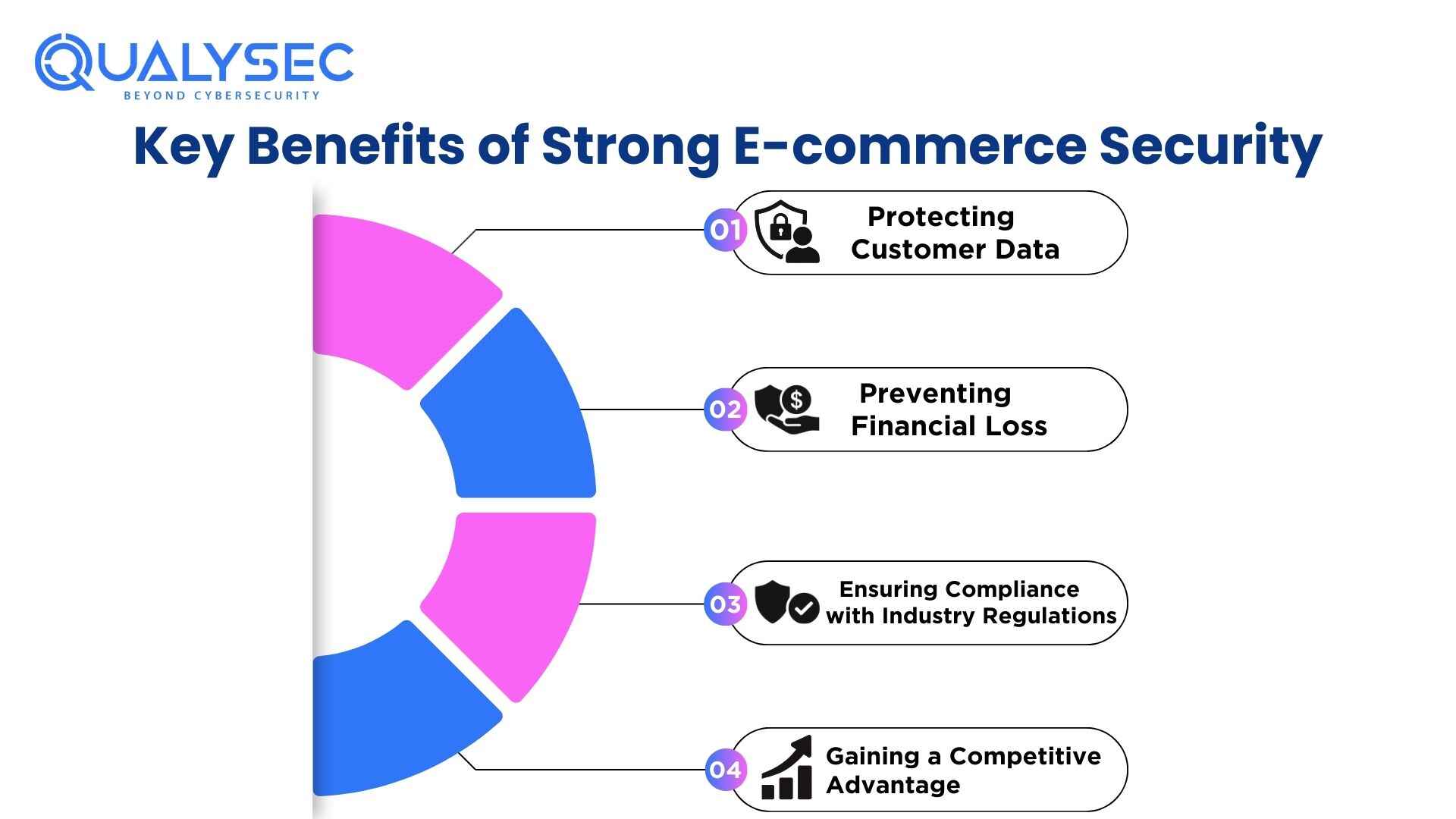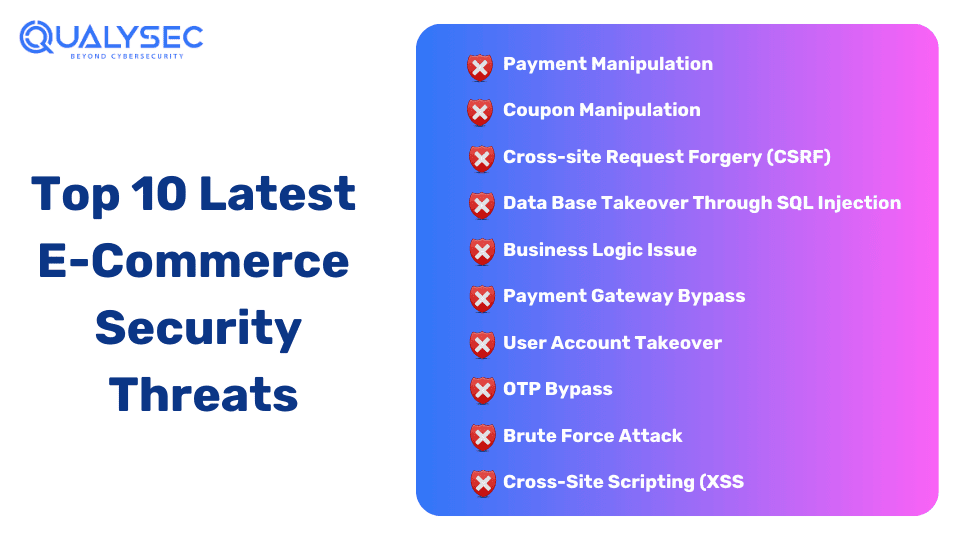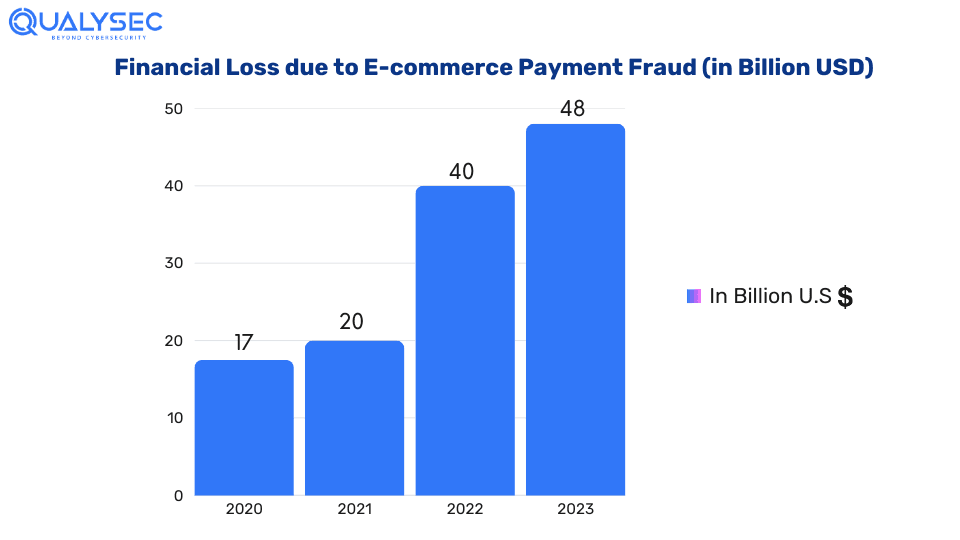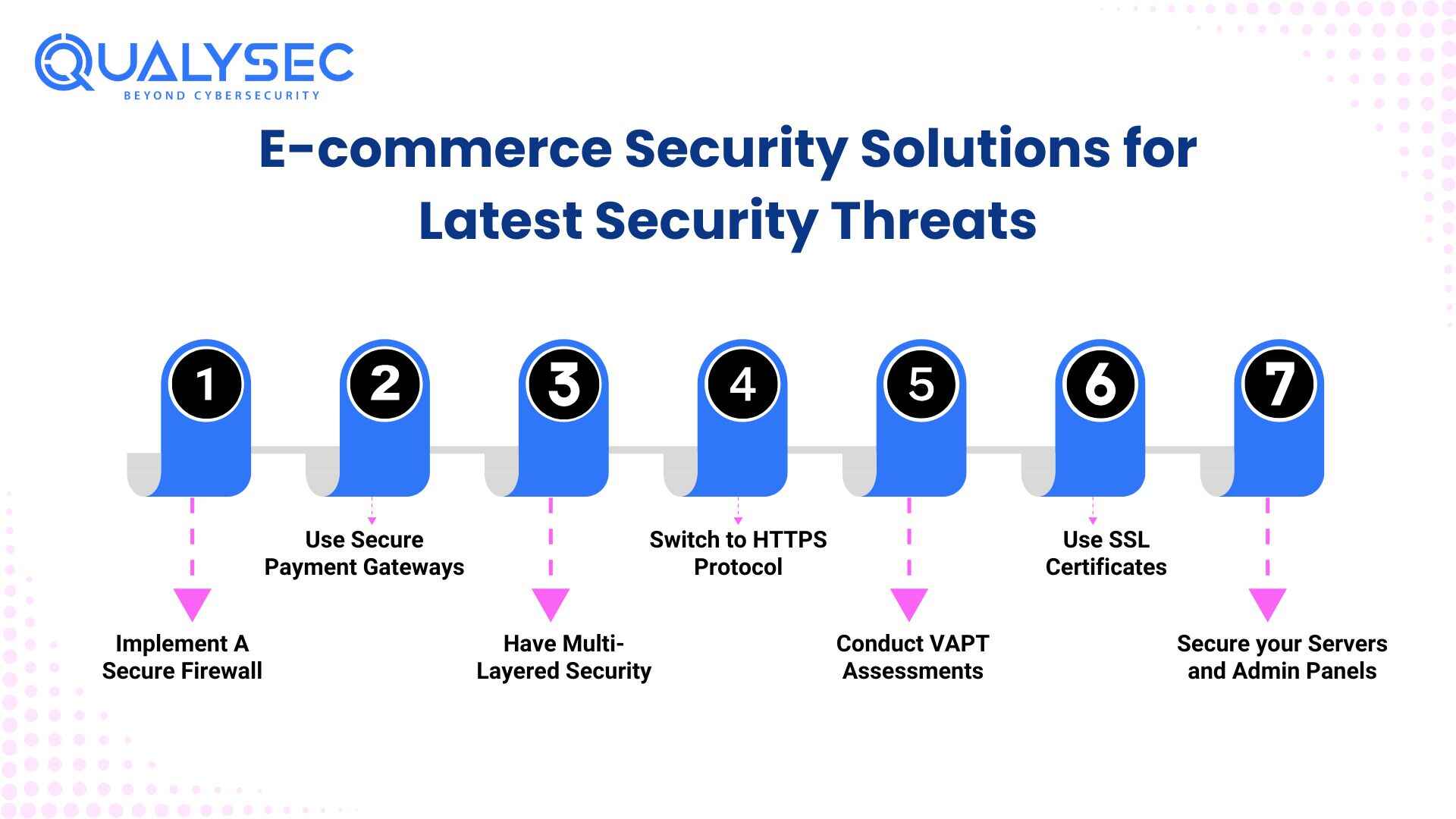E-commerce has revolutionized the way we shop, making online transactions more convenient than ever. However, with the rapid growth of the industry, security threats in e commerce have become more sophisticated, costing online retailers billions of dollars annually. In 2025, the global e-commerce industry continues to be a prime target for cybercriminals due to the vast amount of sensitive customer data and financial transactions it handles. A single breach can lead to severe financial losses, legal penalties, and irreparable damage to brand reputation.
Shocking Statistics on E-commerce Cybersecurity
- Over 38% of cyberattacks now target e-commerce platforms, making it one of the most vulnerable industries.
- E-commerce fraud losses are expected to exceed $50 billion by the end of 2025.
- 80% of businesses that suffer a major breach lose consumer trust, leading to a decline in sales and brand loyalty.
- Ransomware attacks on e-commerce businesses have increased by 65%, with cybercriminals demanding higher payouts than ever before.
Protect Your E-commerce Business from Cyberattacks – Get a Free Security Audit Today!
Why E-commerce Security is More Critical Than Ever
Making sure strong security for your e-commerce website is no longer optional—it’s a necessity. With cybercriminals using advanced tactics like AI-driven phishing attacks, automated botnet fraud, and supply chain compromises, businesses must take a proactive approach to security.
In this blog, we will discuss the top 10 emerging e-commerce security threats in 2025 and provide actionable solutions to safeguard your business against these evolving risks.
Importance of E-commerce Security
A secure e-commerce environment is essential for both businesses and consumers. Without robust security measures, e-commerce platforms risk losing customer trust, facing financial penalties, and falling victim to devastating cyberattacks.
Struggling with security compliance? Ensure your e-commerce platform is PCI DSS, GDPR, and SOC2 compliant with expert-led testing. Schedule a Consultation.
Key Benefits of Strong E-commerce Security
1. Protecting Customer Data
Modern e-commerce platforms collect vast amounts of sensitive information, including credit card details, addresses, and personal identifiers. A data breach can result in identity theft, financial fraud, and significant reputational damage. Implementing encryption, multi-factor authentication (MFA), and secure payment gateways helps protect customer data from cybercriminals.
2. Preventing Financial Loss
With cyberattacks occurring every 39 seconds, your business could be the next target. Cybercriminals exploit vulnerabilities to steal funds, process fraudulent transactions, and disrupt business operations. Investing in security testing, fraud detection systems, and secure API integrations minimizes financial risks.
3. Ensuring Compliance with Industry Regulations
Governments and regulatory bodies worldwide are enforcing stricter cybersecurity laws. Compliance with standards like PCI DSS, GDPR, CCPA, SOC 2, and ISO 27001 is mandatory to protect customer data. Failing to meet these requirements can result in hefty fines, lawsuits, and loss of customer trust.
4. Gaining a Competitive Advantage
Security-conscious customers prefer to shop on websites that prioritize their data protection. Displaying security certifications, using SSL encryption, and providing transparent security policies enhance credibility and encourage repeat business. A well-secured e-commerce platform not only safeguards customer data but also boosts sales and retention rates.
Top 10 Latest Security Threats in E-Commerce
Keeping your e-commerce business running and building a loyal customer base requires you to be ahead of evolving security threats. E-commerce attacks can come in various forms that can disrupt your platform and harm your customer’s account and data. Here are 10 latest e-commerce security threats that you need to be aware of:
1. Payment Manipulation
Payment manipulations are now a severe cyber threat in e-commerce, where cybercriminals exploit vulnerabilities in payment processes to steal money or sensitive information. This type of threat occurs when hackers tamper with customer’s payment data. They redirect funds to their accounts or manipulate transaction details to deceive both customers and vendors. Such cyber threats can result in financial losses and break customer trust.
2. Coupon Manipulation
Coupon manipulation is where fraudsters exploit discounts or promotional offers to cheat the system for personal gain. This type of cyber threat involves the misuse of coupons, such as generating fake or unauthorized codes, exploiting loopholes in the redemption process, or abusing the terms and conditions to get illegal discounts. Coupon manipulation not only results in financial losses but also damages the integrity of promotional campaigns.
3. Cross-Site Request Forgery (CSRF)
In cross-site request forgery (CSRF), the attackers trick users into taking unwanted actions on their behalf, without their consent. For example, they could trick you change your delivery address or payment information. Such attacks can occur when a malicious website or email forces the user to make the necessary changes in the e-commerce platform. It can lead to account takeovers, unauthorized transactions, or data breaches.
4. Data Base Takeover Through SQL Injection
SQL injections allow attackers to gain unauthorized access to sensitive data stored in the website’s database. This type of attack happens when cybercriminals exploit vulnerabilities in the website’s code to insert malicious SQL commands. As a result, the commands manipulate or receive sensitive information from the database. In e-commerce platforms, it could lead to the theft of customer’s private information such as credit card details, addresses, and purchase history.
5. Business Logic Issue
The business logic issue is a significant e-commerce cyber threat that arises from errors in the logic of their operations. These issues occur when the business rules and workflows implemented in the system are not properly validated. This can give rise to vulnerabilities that can be exploited by attackers. In e-commerce, business logic issues can result in various problems such as incorrect pricing, errors in order processing, or unauthorized access to sensitive data.
6. Payment Gateway Bypass
In payment gateway bypass, attackers exploit vulnerabilities in the payment processing system to gain unauthorized access to financial transactions. This type of cyberattack occurs when attackers manipulate payment data during the transaction process, bypassing the payment gateway’s authentication and encryption mechanisms. As a result, they can steal private data such as credit card details, compromise user accounts, or carry out illegal transactions without any detection.
 7. User Account Takeover
7. User Account Takeover
Attackers can easily gain unauthorized access to user accounts in e-commerce websites through various ways such as credential stuffing or exploiting weak passwords. Once an attacker gains access, they can perform many fraudulent activities such as stealing personal information, making unauthorized purchases, or conducting identity theft. This not only results in financial loss but also damages the trustworthiness of the e-commerce platform.
8. OTP Bypass
OTP (One-Time Password) bypass is one of the most recent security threats in e-commerce that everyone needs to be aware of. It is where attackers try to bypass the security measures that rely on OTPs to authenticate users. Here, the attacker intercepts or manipulates the OTP sent to the user’s registered mobile number or email during the authentication process. By exploiting vulnerabilities in OTP delivery or validation, attackers can gain unauthorized access to user accounts. As a result, they can perform fraudulent transactions or steal sensitive data.
9. Brute Force Attack
Nowadays, cybercriminals use automated tools to systematically guess passwords or encryption keys to gain unauthorized access. Brute force attacks basically rely on the sheer volume of attempts made by the attacker to eventually discover the correct credentials through trial and error. After they successfully guess the credentials, they can compromise user accounts, steal personal information, or make fraudulent transactions.
10. Cross-Site Scripting (XSS)
Cross-site scripting (XSS) is where attackers inject malicious scripts into the e-commerce website that are viewed by other users. This type of attack occurs when the website fails to validate user inputs, which allows attackers to inject harmful scripts that can steal sensitive information, hijack user activities, or redirect users to malicious websites. It will eventually lead to data theft and financial loss.
How vulnerable is your e-commerce site? Identify security gaps before hackers do! Book a VAPT Assessment today.
E-commerce Security Solutions for Latest Security Threats
All these above-mentioned security threats in e commerce require top security solutions. Here is a noteworthy list of 7 e-commerce security solutions that can ease your life:
Solution 1 – Implement A Secure Firewall
A strong firewall system can detect and stop various cyberattacks on the e-commerce platform. It acts like a shield against malicious traffic and ensures your website stays accessible. Additionally, it blocks suspicious networks, cross-site scripting (XSS), and SQL injections. It also helps manage the network traffic flow to and from your online store.
Solution 2 – Use Secure Payment Gateways
Avoid keeping customer credit card information in your database. Instead, use third-party services like Stripe and PayPal to handle payment transactions off-site. This protects your customer’s personal and financial information in a better way. Also, if your business stores financial data, ensure compliance with PCI DSS regulations.
Solution 3 – Have Multi-Layered Security
Use a strong multi-layer security system, which includes using CAPTCHA tests and bot detection tools. This will differentiate between genuine users and malicious bots that hackers use. You can also add multi-factor authentication for additional security to protect your site from unauthorized access. Some other popular multi-layered security methods include:
-
- OTP (one-time password) along with personal ID
Solution 4 – Switch to HTTPS Protocol
Using outdated HTTP protocol can be a huge security risk for your e-commerce website and your customers. Use HTTPS to encrypt data sent between users’ browsers and your site. This will display a trustworthy “green lock” symbol on the URL bar, assuring customers that their private information is protected. Additionally, switching to HTTPS also helps you rank better in Google search engine results.
Solution 5 – Conduct VAPT Assessments
Employ a third-party cybersecurity company to perform vulnerability assessment and penetration testing (VAPT) on your e-commerce platform. VAPT is the process of identifying and exploiting vulnerabilities present in the applications, websites, and networks that could lead to a cyberattack. As a result, you can fix these vulnerabilities and make your security stronger. Additionally, the VAPT report also helps you comply with necessary industry regulations, preventing legal penalties and fines.
Want to see a real VAPT report? Simply click below and download it instantly!
Latest Penetration Testing Report

Solution 6 – Use SSL Certificates
Secure Sockets Layer (SSL) certificates are files or keys that secure transactions across different paths on a network. These certificates are linked to credit card details and transactions to regular queries. They encrypt data and secure the information you send from your end to the server. If you are doing any kind of business transactions on your website, you require SSL certificates.
Solution 7 – Secure your Servers and Admin Panels
Most e-commerce platforms often come with default passwords that are very easy to guess. If you don’t change them, you are opening yourself up for a possible attack. Use complex passwords and usernames (characters, symbols, and numbers) and change them frequently. You can also go one step further by making the panel notify you whenever an unknown IP tries logging in.
Conclusion
Security threats in e-commerce are evolving and getting more vigilant. This means, businesses must implement a variety of strong security measures to protect their e-commerce websites and applications from cybercriminals.
The solutions listed in this blog are some of the best e-commerce cybersecurity practices that you can adopt to enhance your security posture. By implementing these security measures, you can protect your customer data, prevent financial losses, and maintain your reputation in the online market.
Qualysec Technologies offers process-based VAPT services tailored for e-commerce businesses. Secure your online store today! Get Started.
Talk to our Cybersecurity Expert to discuss your specific needs and how we can help your business.
FAQs
Q: What are the security threats in e commerce?
A: The biggest security threats in e-commerce include:
- Payment Manipulation
- Data Base Takeover Through SQL Injection
- Payment Gateway Bypass
- OTP Bypass
- Brute Force Attack
- Cross-Site Scripting (XSS)
Q: What is e-commerce security?
A: E-commerce security is the protection of e-commerce websites, applications, and APIs from unauthorized access, data breaches, and destruction or alteration of user activities.
Q: What is the cyber risk of e-commerce?
A: The e-commerce industry accounts for 32% of all cyberattacks globally. This is because e-commerce platforms store highly sensitive customer data and manage payment transactions. Also, most e-commerce companies lack high-quality cybersecurity.








 7. User Account Takeover
7. User Account Takeover


















![Top 20 Network Security Companies in USA [2025 Updated List]](https://qualysec.com/wp-content/uploads/2025/05/Top-20-Network-Security-Companies-in-USA-2025-Updated-List-scaled.jpg)


































































































































































































































































































































































































































































































0 Comments